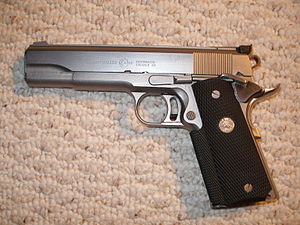AMT Hardballer
| AMT Hardballer | |
|---|---|
 AMT Hardballer .45 ACP | |
| Type | Semi-automatic pistol |
| Place of origin | United States |
| Production history | |
| Manufacturer | Arcadia Machine & Tool, Galena Industries |
| Produced | 1977 - 2002 |
| Variants | Accelerator, Commando, Government, Javelina, Longslide, Skipper |
| Specifications | |
| Mass | 38 oz (1,077 g) 46.06 oz (1,306 g) (Longslide) |
| Length | 8.5 in (216 mm) 10.5 in (267 mm) (Longslide) |
| Barrel length | 4 in (102 mm) (Commando, Skipper) 5 in (127 mm) (Hardballer, Government) 7 in (178 mm) (Accelerator, Longslide, Javelina) |
| Cartridge | .45 ACP 10mm Auto (Javelina) .40 S&W (Commando) .400 Corbon (Accelerator) |
| Action | Short recoil operated, locked breech |
| Feed system | 7-round box magazine 8-round magazine (Commando, Javelina) |
| Sights | Fully adjustable Millett rear sight; front blade Fixed sights on Government models |
The AMT Hardballer is a series of pistols that are a clone of the .45 ACP Colt M1911 made by Arcadia Machine & Tool (AMT) from 1977 to 2002.[1] The Hardballer was the first entirely stainless steel 1911 pattern pistol.[2] Other features included adjustable rear sights and a lengthened grip safety.[3]
Overview
The Hardballer derives its name from round-nose hardball G.I. ammunition (solid 230 grain Full Metal Jacketed bullets). This is the round the pistol was designed to shoot.
The Hardballer series of pistols all share a brushed stainless steel finish and a wide target style trigger with adjustable trigger stop. The later Galena-made pistols have an elongated "beavertail" grip safety and a beveled magazine well.[4]
Variants
- AMT Hardballer: was an all stainless steel version of the Colt Gold Cup, fitted with Micro rear sights.[5]
- AMT Combat Government: was developed as a sports pistol but in 1978 AMT marketed the Combat Government, an M1911 clone with fixed sights for police departments. Since 1985, this model has been called the Government with the term "Combat" omitted.[5]
- AMT Longslide: A version with an extended 7 in (178 mm) barrel, introduced in 1980. It has the same qualities as the Hardballer but with slide and barrel lengthened by 2 in (51 mm).[5]
- AMT Skipper: A compact version of the Hardballer introduced in 1980. It features a 4 in (102 mm) barrel. In 1984, the Skipper disappeared from AMT's range.[5]
- AMT Commando: Originally offered by AMT then improved and reintroduced in 2000 (this date in question) under the Galena Industries brand. The original AMT Commando was a 5 in (127 mm) barreled version and did not have a loaded chamber indicator nor beavertail grip safety. The improved Commando is a compact model of the 5 in (127 mm) Government with a 4 in (102 mm) barrel but retaining the frame of the Government model. It is chambered in .40 S&W and has an 8-round magazine capacity.[5]
- AMT Accelerator: Basically a Galena-made Longslide chambered for the powerful .400 Corbon cartridge featuring a 7 in (178 mm) barrel and an elongated beavertail.[4]
- AMT Javelina: A longslide variant chambered in the 10mm Auto caliber with an 8-round capacity magazine.[5]
In popular Culture
The Longslide version was the pistol used by Arnold Schwarzenegger in the 1984 film, The Terminator.[6]
In the Hitman video game series, dual custom AMT Hardballers (called 'Silverballers' in Hitman: Contracts, Hitman: Blood Money, and Hitman: Absolution) are 47's signature weapons.[7]
In the video game Resident Evil 4, the AMT Longslide makes a appearance, named the Killer 7. It is the second "Magnum" type pistol obtainable in the game.
In Lee Childs' Jack Reacher book "Bad Luck and Trouble," AMT Hardballers are the weapons used by 2 drug dealers in an ill advised attempt to recoup $900 stolen from them by Reacher.
In the anime Black Lagoon, Mr. Chang wields dual custom AMT Hardballer Longslides.
References
- ^ Jones, Richard D.; White, Andrew (27 May 2008). Jane's Guns Recognition Guide 5e. Harper Collins. p. 100. ISBN 978-0-06-137408-1. Retrieved 25 May 2013.
- ^ Shideler, Dan (2010). Gun Digest 2011. Iola, Wisconsin: Krause Publications. p. 114. ISBN 978-1-4402-1561-2. Retrieved 25 May 2013.
- ^ Hartink, A.E. (2002). The Complete Encyclopedia of Pistols and Revolvers. Edison, New Jersey: Chartwell Books, Inc. pp. 87–88. ISBN 978-0-7858-1519-8.
- ^ a b Dan Shideler; Jerry
Lee (2012). 2012 Standard Catalog of Firearms: The Collector's Price & Reference Guide. Iola
Wisconsin: Krause Publications. pp. 50–51, 472. ISBN 978-1-4402-1688-6. Retrieved 25
May 2013.
{{cite book}}: Check date values in:|accessdate=(help); line feed character in|accessdate=at position 3 (help); line feed character in|author2=at position 6 (help); line feed character in|location=at position 6 (help); line feed character in|title=at position 58 (help) Cite error: The named reference "ShidelerLee2012" was defined multiple times with different content (see the help page). - ^ a b c d e f Peterson, Phillip (16 September 2011). Gun Digest Book of Modern Gun Values. Iola, Wisconsin: Gun Digest Books. p. 91. ISBN 978-1-4402-1831-6. Retrieved 25 May 2013.
- ^ Scott W. Wagner (2009). Own the Night: Selection and Use of Tactical Lights and Laser Sights. Iola, Wisconsin: Gun Digest Books. p. 9. ISBN 978-1-4402-0371-8. Retrieved 25 May 2013.
- ^ Benson, Raymond (30 October 2012). Hitman: Damnation. New York: Random House Publishing Group. p. 29. ISBN 978-0-345-53585-6. Retrieved 26 May 2013.
